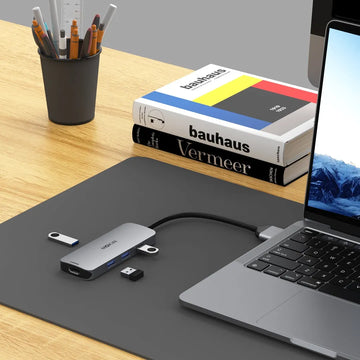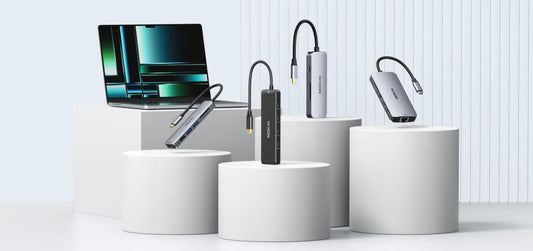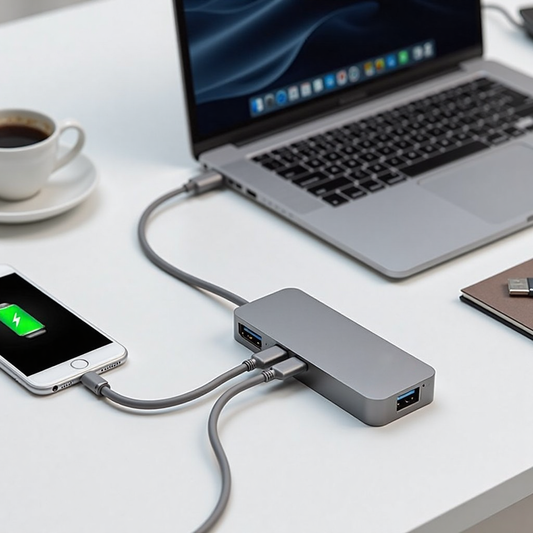How to Select the Right USB Multifunctional Hub?
Contents
I. Introduction
In today's digital age, a USB hub is an essential accessory. It provides more additional ports and functionalities for your PCs, notebooks, mobile phones, tablets, and gaming consoles.
USB multifunctional hubs attach to a laptop to provide additional ports. These hubs include USB ports, SD card slots, headphone outlets and more. USB hubs are compact and user-friendly, enhancing the functionality of your laptop.
A USB hub expands the number of available USB ports on an electronic device. It allows you to connect multiple USB devices simultaneously, even if your device has limited USB ports. Therefore, USB hubs are essential for users.
A USB hub eliminates the need for constantly switching devices or repeatedly unplugging and plugging them back in.
These hubs are compatible with different USB versions such as USB 2.0, USB 3.0, and USB 3.1. It allows you to connect devices with different specifications to a single hub.
USB hubs help transfer data between devices and the computer. You can access data from multiple USB devices simultaneously. Additionally, some USB hubs feature charging ports, allowing you to power essentials without a separate charger.
Various types of USB hubs exist. USB hubs are available in the form of portable hubs, desktop hubs, and docking stations.
The features make you choose the best USB hubs that suit your needs. Portable hubs are good for travel, while desktop hubs are better for stationary use or offices. Both are useful for different situations.
USB hubs keep your workspace organized. Managing all connected USB devices improves efficiency.
USB hubs help connect multiple devices, organize workspace, transfer data, and simplify device usage.
II. How Do USB Hubs Work?

Some PC users need multiple ports for connecting more peripherals. The port USB hub is the bridge between the host computer and connected devices.
The host connects a USB hub using a USB cable. Plug one end of the cable into a USB port on the host, and the other end into the USB port on the hub.
The controller chip of a hub is responsible for data transfer, power distribution, and display extension. It help every device connected get enough power to work, either from the host or the hub's power source.
A USB hub lets you connect and use many USB devices at once, giving your computer or device more ways to connect. The hub simplifies the process of connecting and managing USB devices, improving convenience.
III. Types and Specifications
Differences between USB 2.0 Hubs and USB 3.0 Hubs

Nowadays, USB has become an necessary technology for connecting various devices.
Recognize the key differences between USB 2.0 and 3.0 before selecting a powered USB hub for your workstation.
USB 2.0 supports a bandwidth of 480Mbps. Many devices, including keyboards, mice, and older external hard drives, widely use USB 2.0.
USB 3.0 is the third version of the USB standard. It offers a significant increase in performance over USB 2.0, with a theoretical maximum bandwidth of 5Gbps.
Faster speed helps transfer data quickly. It also boosts performance for devices like external hard drives and high-resolution cameras.
USB hub 3.0 is down-compatible with USB 2.0 devices. USB 3.0 cables are typically thicker and better shielded to support higher data transfer rates.
USB C to USB 3 hubs offer improved power management compared to USB 2.0. It provides higher maximum bus power, allowing devices to draw more power from the host. Powered USB 3.0 hubs reduce power consumption when devices are not in use, leading to better work efficiency.
Consider your specific needs to purchase a reliable USB expansion hub for your device. If you have a USB 3.0 device, it is best to choose a USB 3.0 hub to obtain better performance.
However, if you primarily use USB 2.0 devices, a USB 2.0 hub is enough. You'd better buy a high-quality USB hub from a well-known brand. Try to find hubs with reliable performance and good user reviews.
IV. How to Make a USB Hub Wireless

What is a Wireless USB hub?
Lots of laptops with few physical ports support wireless connections through Wi-Fi and Bluetooth. Wireless USB is a way to connect multiple devices, with a short range and fast data transfer. People commonly use it for mice and keyboards. Besides, they provide users better flexibility and convenience.
Connect devices to your hub and then turn on the Wi-Fi. A wireless connection to your PC is available. The USB-to-Wi-Fi link allows you to access USB devices through the network.
The Advantages of Wireless USB Hubs
Wireless USB-to-USB hubs work as a solution that extends the functionality of USB hubs.
Wireless USB hubs are a more efficient alternative to common USB hubs.
Wireless USB hubs enable you to access remote USB devices without cable limitations. Users access several similar USB devices over the network at the same time. This feature is ideal for multiple people sharing a USB device, such as a scanner or printer.
They need fewer physical cables, saving space for your workstation. Less cables mean a tidy and organized workspace setup.
Remote wireless connections don't need extra hardware, which helps you control the budget.
They are applicable to Windows, macOS, and Linux. So sharing USB devices between different systems is available.
Setting up a USB hub with Wi-Fi using the USB Network Gate program is easy. Just follow the directions to achieve proper connectivity.

Users can connect wireless by plugging a USB hub into a port on their wireless router. This will add the USB hub to the network. Or explore the benefits of available dedicated wireless USB hubs and their functionality. With a built-in router, wireless USB hubs can be portable chargers for your peripheral.
V. Powered & Unpowered USB Hubs

Two kinds of hubs exist: one that powers itself when connecting to your PC, while the other needs a separate power outlet.
They are designed to power higher voltage devices such as printers, external hard drives, and others.
Unpowered hubs draw limited power from the computer and can only distribute it to connected peripherals. The feature affects the overall performance. Compared to USB power hubs, unpowered hubs are more portable and compact. In addition, you don't have to find a separate power outlet.
Differences between Powerful USB hubs and Unpowered USB Hubs
The difference between a powerful USB hub and a regular USB hub mainly lies in the output power.
The best powered USB hub has high power output capability. It can provide sufficient power to high-voltage devices such as external hard drives, gaming consoles, and so on. USB C powered hubs typically have their power chargers or additional power ports to ensure an ample power supply.
A basic USB hub is useful for connecting keyboards, mice, USB drives, and other low-power devices. Regular USB hubs are usually bus-powered, drawing power from the host device through USB connectors.
Choosing the right type of USB hub for your personal needs is crucial to ensure proper device functionality and power supply.
Using a USB hub that has no sufficient power may lead to degraded performance, data transfer, or other problems. By choosing a USB hub that matches your device, you can ensure smooth and reliable operation.
Ⅵ. Conclusion
When choosing USB hubs, make sure to consider all factors. These factors include data transfer, hubs for Ethernet, wireless connectivity, and power needs. Please ensure an optimized user experience and device performance while avoiding compatibility issues and power limitations.
Choosing the correct USB hub and power supply improves user experience and device performance.
To learn more about MST hubs, please refer to the following links:

MOKiN 13-IN-1 USB-C Laptop Charging Station with 2.26-inch LCD Smart Display








